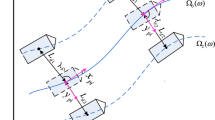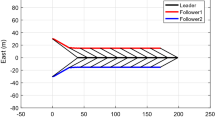Abstract
This paper addresses the formation tracking control problem of multiple underactuated unmanned surface vehicles. Considering many actual situations, a practical formation control scheme, which is performed by using a leader-follower approach, minimum learning parameter technique, adaptive technology and so on. Firstly, a virtual unmanned surface vehicle is designed according to the location information of the leader unmanned surface vehicle to estimate the leader’s speed information while reducing the communication bandwidth. Secondly, a formation control law is designed to make the follower underactuated unmanned surface vehicles track the leader. Unknown dynamics and external disturbances are regarded as a whole and compensated by the minimum learning parameter technique instead of multi-layer neural network and the neural shunt model can handle multiple derivation problems of virtual control laws. Meanwhile, the robustness of the controlled system is improved through adaptive technology. Besides, an auxiliary design system is employed to constrain the output range of the control law. Finally, numerical simulations are implemented to prove the feasibility of the formation tracking control strategy.
Similar content being viewed by others
References
C. W. Power, R. Hanlon, H. Grothe, A. J. Prussin, L. C. Marr, and D. G. Schmale, “Coordinated sampling of microorganisms over freshwater and saltwater environments using an unmanned surface vehicle (USV) and a small unmanned aircraft system (sUAS),” Frontiers in Microbiology, vol. 16, pp. 1668–1679, 2018.
D. D. Mu, G. F. Wang, and Y. S. Fan, “Tracking control of podded propulsion unmanned surface vehicle with unknown dynamics and disturbance under input saturation,” International Journal of Control, Automation and Systems, vol. 16, no. 4, pp. 1905–1915, 2018.
Y. Ma, M. Hu, and X. Yan, “Multi-objective path planning for unmanned surface vehicle with currents effects,” ISA Transactions, vol. 75, pp. 137–156, 2018.
Z. Jia, Z. Hu, and M. Zhang, “Adaptive output-feedback control with prescribed performance for trajectory tracking of underactuated surface vessels,” ISA Transactions, vol. 95, pp. 18–26, 2019.
N. Wang, X. Jin, and M. J. Er, “A multilayer path planner for a USV under complex marine environments,” Ocean Engineering, vol. 184, pp. 1–10, 2019.
F. Rego, N. T. Hung, and A. M. Pascoal, “Cooperative path-following of autonomous marine vehicles: theory and experiments,” Proc. of IEEE/OES Autonomous Underwater Vehicle Workshop (AUV), IEEE, pp. 1–6, 2018.
N. Gu, D. Wang, Z. Peng, and L. Liu, “Adaptive bounded neural network control for coordinated path-following of networked underactuated autonomous surface vehicles under time-varying state-dependent cyber-attack,” ISA Transactions, 2019. DOI: https://doi.org/10.1016/j.isatra.2018.12.051
Z. Sun, G. Zhang, Y. Lu, and W. Zhang, “Leader-follower formation control of underactuated surface vehicles based on sliding mode control and parameter estimation,” ISA Transactions, vol. 72, pp. 15–24, 2018.
S. B. Park, “Adaptive formation control of underactuated autonomous underwater vehicles,” Ocean Engineering, vol. 96, pp. 1–7, 2015.
J. Ghommam and M. Saad, “Adaptive leader-follower formation control of underactuated surface vessels under asymmetric range and bearing constraints,” IEEE Transactions on Vehicular Technology, vol. 67, no. 2, pp. 852–865, 2017.
K. Shojaei, “Leader-follower formation control of under-actuated autonomous marine surface vehicles with limited torque,” Ocean Engineering, vol. 105, pp. 196–205, 2015.
P. K. C. Wang, “Navigation strategies for multiple autonomous mobile robots moving in formation,” Journal of Robotic Systems, vol. 8, no. 2, pp. 177–195, 1991.
F. Fahimi, “Sliding-mode formation control for underactuated surface vessels,” IEEE Transactions on Robotics, vol. 23, no. 3, pp. 617–622, 2007.
L. Ding and G. Guo, “Formation control for ship fleet based on backstepping,” Control and Decision, vol. 27, no. 2, pp. 299–303, 2012.
R. Cui, S. S. Ge, B. V. E. How, and Y. S. Choo, “Leader-follower formation control of underactuated autonomous underwater vehicles,” Ocean Engineering, vol. 37, no. 17–18, pp. 1491–1502, 2010.
Z. Yang, Y. Wang, and Z. Liu, “Sliding mode robust control for formation of multiple underactuated surface vessels,” Electric Machines and Control, vol. 18, no. 11, pp. 90–96, 2014.
Z. Sun, G. Zhang, Y. Lu, and W. Zhang, “Leader-follower formation control of underactuated surface vehicles based on sliding mode control and parameter estimation,” ISA Transactions, vol. 72, pp. 15–24, 2018.
K. Shojaei, “Leader-follower formation control of underactuated autonomous marine surface vehicles with limited torque,” Ocean Engineering, vol. 105, pp. 196–205, 2015.
R. W. Beard, J. Lawton, and F. Y. Hadaegh, “A coordination architecture for spacecraft formation control,” IEEE Transactions on Control Systems Technology, vol. 9, no. 6, pp. 777–790, 2001.
T. Glotzbach, M. Schneider, and P. Otto, “Cooperative line of sight target tracking for heterogeneous unmanned marine vehicle teams: from theory to practice,” Robotics and Autonomous Systems, vol. 67, pp. 53–60, 2015.
Z. Hu, C. Ma, L. Zhang, A. Halme, and T. Hayat, “Formation control of impulsive networked autonomous underwater vehicles under fixed and switching topologies,” Neurocomputing, vol. 147, pp. 291–298, 2015.
M. Bibuli, G. Bruzzone, M. Caccia, A. Gasparri, A. Priolo, and E. Zereik, “Swarm-based path-following for cooperative unmanned surface vehicles,” Proceedings of the Institution of Mechanical Engineers, Part M: Journal of Engineering for the Maritime Environment, vol. 228, no. 2, pp. 192–207, 2014.
F. Arrichiello, S. Chiaverini, and T. I. Fossen, “Formation control of underactuated surface vessels using the null-space-based behavioral control,” Proc. of IEEE/RSJ International Conference on Intelligent Robots and Systems, IEEE, pp. 5942–5947, 2006.
Z. Peng, D. Wang, Z. Chen, X. Hu, and W. Lan, “Adaptive dynamic surface control for formations of autonomous surface vehicles with uncertain dynamics,” IEEE Transactions on Control Systems Technology, vol. 21, no. 2, pp. 513–520, 2012.
J. Ghommam and M. Saad, “Adaptive leader-follower formation control of underactuated surface vessels under asymmetric range and bearing constraints,” IEEE Transactions on Vehicular Technology, vol. 67, no. 2, pp. 852–865, 2017.
L. Liu, D. Wang, Z. Peng, and T. Li, “Modular adaptive control for LOS-based cooperative path maneuvering of multiple underactuated autonomous surface vehicles,” IEEE Transactions on Systems, Man, and Cybernetics: Systems, vol. 47, no. 7, pp. 1613–1624, 2017.
D. Mu, G. Wang, Y. Fan, and Y. Zhao, “Modeling and identification of podded propulsion unmanned surface vehicle and its course control research,” Mathematical Problems in Engineering, vol. 2017, Article ID 3209451, pp. 1–13, 2017.
D. P. Li, Y. J. Liu, S. C. Tong, C. L. P. Chen, D. J. Li, “Neural networks-based adaptive control for nonlinear state constrained systems with input delay,” IEEE Transactions on Cybernetics, vol. 49, no. 4, pp. 1249–1258, 2018.
Y. Li, K. Li, and S. Tong, “Finite-time adaptive fuzzy output feedback dynamic surface control for MIMO non-strict feedback systems,” IEEE Transactions on Fuzzy Systems, vol. 27, no. 1, pp. 96–110, 2019.
Y. Li, K. Sun, and S. Tong, “Observer-based adaptive fuzzy fault-tolerant optimal control for SISO nonlinear systems,” IEEE Transactions on Cybernetics, vol. 49, no. 2, pp. 649–661, 2019.
Y. Li, T. Yang, and S. Tong, “Adaptive neural networks finite-time optimal control for a class of nonlinear systems,” IEEE Transactions on Neural Networks and Learning Systems, 2019. DOI: https://doi.org/10.1109/TNNLS.2019.2955438
H. Wang, D. Wang, and Z. Peng, “Neural network based adaptive dynamic surface control for cooperative path following of marine surface vehicles via state and output feedback,” Neurocomputing, vol. 133, pp. 170–178, 2014.
D. D. Mu, G. F. Wang, and Y. S. Fan, “Design of adaptive neural tracking controller for pod propulsion unmanned vessel subject to unknown dynamics,” Journal of Electrical Engineering & Technology, vol. 12, no. 6, pp. 2365–2377, 2017.
R. Skjetne, Ø. N. Smogeli, and T. I. Fossen, “A nonlinear ship manoeuvering model: identification and adaptive control with experiments for a model ship,” Modeling, Identification and Control, vol. 25, no. 1, pp. 3–27, 2004.
G. Zhang, X. Zhang, and Y. Zheng, “Adaptive neural path-following control for underactuated ships in fields of marine practice,” Ocean Engineering, vol. 104, pp. 558–567, 2015.
G. Zhang and X. Zhang, “Concise adaptive fuzzy control of nonlinearly parameterized and periodically time-varying systems via small gain theory,” International Journal of Control, Automation and Systems, vol. 14, no. 4, pp. 893–905, 2016.
Y. Yang, C. Zhou, and X. Jia, “Robust adaptive fuzzy control and its application to ship roll stabilization,” Information Sciences, vol. 142, no. 1–4, pp. 177–194, 2002.
Y. Yang and J. Ren, “Adaptive fuzzy robust tracking controller design via small gain approach and its application,” IEEE Transactions on Fuzzy Systems, vol. 11, no. 6, pp. 783–795, 2003.
J. L. Du and C. E. Yang, “Adaptive nonlinear design of autopilot for ship course tracking,” Journal of Applied Sciences, vol. 24, no. 1, pp. 83–88, 2006.
C. Z. Pan, X. Z. Lai, S. X. Yang, and M. Wu, “A biologically inspired approach to tracking control of underactuated surface vessels subject to unknown dynamics,” Expert Systems with Applications, vol. 42, no. 4, pp. 2153–2161, 2015.
M. Chen, S. S. Ge, and B. Ren, “Adaptive tracking control of uncertain MIMO nonlinear systems with input constraints,” Automatica, vol. 47, no. 3, pp. 452–465, 2011.
E. Panteley and A. Loria, “On global uniform asymptotic stability of nonlinear time-varying systems in cascade,” Systems & Control Letters, vol. 33, no. 2, pp. 131–138, 1998.
A. Widyotriatmo, K. S. Hong, and L. H. Prayudhi, “Robust stabilization of a wheeled vehicle: Hybrid feedback control design and experimental validation,” Journal of Mechanical Science and Technology, vol. 24, no. 2, pp. 513–520, 2010.
A. P. Aguiar and A. M. Pascoal, “Dynamic positioning and way-point tracking of underactuated AUVs in the presence of ocean currents,” International Journal of Control, vol. 80, no. 7, pp. 1092–1108, 2007.
D. Mu, G. Wang, Y. Fan, X. Sun, and B. Qiu, “Modeling and identification for vector propulsion of an unmanned surface vehicle: Three degrees of freedom model and response model,” Sensors, vol. 18, no. 6, pp. 1889–1910, 2018.
Author information
Authors and Affiliations
Corresponding author
Additional information
Publisher’s Note
Springer Nature remains neutral with regard to jurisdictional claims in published maps and institutional affiliations.
Recommended by Associate Editor Augie Widyotriatmo under the direction of Editor Myo Taeg Lim.
This work was supported in part by National Natural Science Foundation of China under Grant 51609033, Natural Science Foundation of Liaoning Province under Grant 20180520005, the Key Development Guidance Program of Liaoning Province of China under Grant 2019JH8/10100100, the Soft Science Research Program of Dalian City of China under Grant 2019J11CY014 and Fundamental Research Funds for the Central Universities under Grant 3132019005, 3132019311.
Dong Dong Mu received his Ph.D. degree from Dalian Maritime University in 2020. He is currently a Lecturer in Dalian Maritime University. His research interests include modeling and intelligent control of unmanned surface vehicle.
Guo Feng Wang received his Ph.D. degree from Dalian Maritime University. He is currently a Professor in Dalian Maritime University, and his research interests include ship automation, advanced ship borne detection device and advanced power transmission.
Yun Sheng Fan received his Ph.D. degree from Dalian Maritime University in 2012. He is currently an Associate Professor in Dalian Maritime University, and his research interests are ship intelligent control and its application.
Rights and permissions
About this article
Cite this article
Mu, D.D., Wang, G.F. & Fan, Y.S. Formation Control Strategy for Underactuated Unmanned Surface Vehicles Subject to Unknown Dynamics and External Disturbances with Input Saturation. Int. J. Control Autom. Syst. 18, 2742–2752 (2020). https://doi.org/10.1007/s12555-019-0611-6
Received:
Revised:
Accepted:
Published:
Issue Date:
DOI: https://doi.org/10.1007/s12555-019-0611-6




